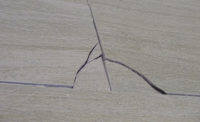Thin set and the new large and heavy tile mortars serve several functions within a tile assembly. They bond to the substrate, support the tile and bond to the back of the tile. When these three key elements are provided, the job will last for many trouble-free years.
However, there are other factors that also contribute to this success. The selection of the appropriate trowel type and notch size is critical. For instance, when a “v” notched trowel is used, the narrow point of the notch does not provide the coverage necessary to properly support the underside of the tile. Using a notch which is too small will not allow enough mortar to be applied and likewise not support the tile.
Experience has shown that troweling the mortar in one direction, as seen in the National Tile Contractors Association’s (NTCA) Trowel & Error video, yields the best mortar coverage on the back of the tile. Here the mortar is troweled in a left to right direction; the tile is then placed into the mortar and moved in a back-and-forth motion perpendicular to the trowel ridges. This movement collapses the trowel ridges into the valleys, leaving very few to no voids in the mortar which supports the entire back of the tile.
Additionally, the mortar must be spread completely up to the layout line. Installers who stay away from the chalk line in order to eliminate mortar squeezing up in the grout joints leave dangerous voids, which can result in catastrophic failure—especially in areas subject to high heels or point loads such as pallet jacks, pianos or a refrigerator.
Experience is a great teacher, but failing to follow established methods and best practices may result in long-term issues. In the attached photo, you can see that two adjacent tiles are broken, with those pieces being much lower than the unbroken tile around them. The cause of the failure was multi-faceted. The installer did not spread the mortar with a recommended trowel, there was no mortar at the edge of the tile and the installer was not qualified. The installer in this case had been placing tile for a grand total of three weeks. The tile industry gets another black eye and an unhappy customer. Using qualified labor provides the best possibility for success and continued quality.









